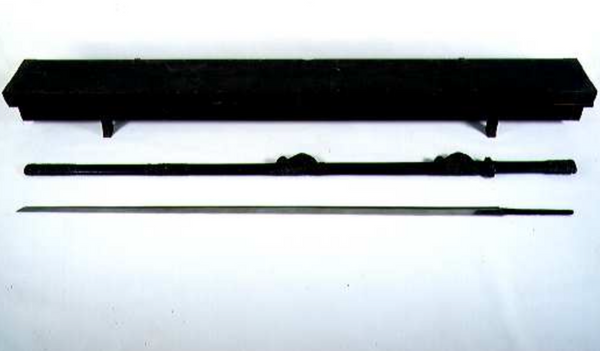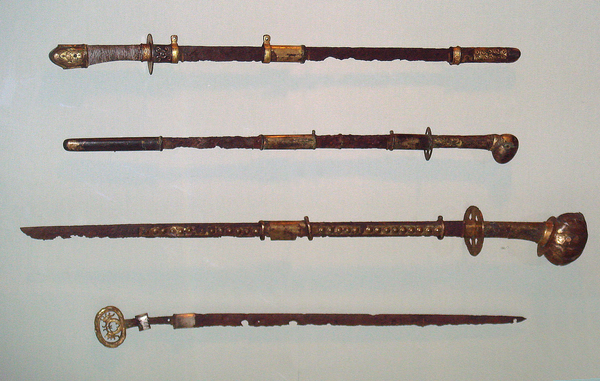What is Chokuto? A complete guide to understand the Japanese Straight sword
What is Chokuto 直刀?

Chokuto in Japanese literally translated to "Straight Sword" , The character 直 (choku) means "straight", and 刀 (tō) means "sword". These straight sword were widely used from the Kofun period to the middle of the Heian period. Swords made in this time are known as the "Jokoto 上古刀", which means "ancient swords" in Japanese. The chokuto was made before the curved swords, generally called "wanto 湾刀" in Japanese. Wanto swords are thought to be the early version of the Katana we know today.
Nowadays Chokuto is more often seen as Ninjato, a straight katana used by Ninja. If you want to buy a Chokuto, you can buy a custom ninjato which is almost the same.
Table of Content
- Chokuto Features
- Material of Chokuto
- How long is a Chokuto
- History of Chokuto
- Famous Chokuto
- Chokuto VS Katana
- Chokuto VS Ninjato
Chokuto Features
Unlike the famous katana, Chokuto has no curve (Sori), pretty much like the Chinese Tang Dao, it is a single edged, straight sword. It's because from Kofun to Heian period, Japan was heavily influenced by China. In these periods, the design of Japanese weapons was largely based on Chinese models (Chinese swords and Dao), they were almost identical to the Chinese weapons from the Han to the Tang dynasties.
In popular culture, especially in anime, movies, and TV shows, the katana is far more commonly featured than the chokuto. But there are still some famous anime swords are Chokuto, for example the Sword of Kusanagi (Sasuke Uchiha) from Naruto, is a Chokuto.
Material of Chokuto

Chokuto swords are often found as rusted artifacts, making it hard to identify their exact ages. However, the koshirae (sword fitting) are usually in better condition and help identify the sword's type through their materials and decorations.
These swords were made not just with iron but also contained copper, indicating the use of meteoric iron and the early adoption of the crucial folding and forging technique in Japanese sword-making. Chokuto began to feature decorative elements like gold and silver, not just on the hilt but also on the koshirae. These ornate swords were not intended for battle but were valued by the elite for ceremonial purposes, as ritual objects, presentation pieces, and gifts.
How long is a Chokuto

Usually, the chokuto blade length is about 60 cm (about 23.6 inches), and the tang is about 12 cm (about 4.7 inches), with an overall length of about 70 cm (about 27.6 inches), shorter than uchigatana or tachi. However, the longest Chokuto is 260 cm (about 102.4 inches) long, which is the Chokuto Kuro Urushi Heimon Tachi Koshirae (Chokuto with plain black lacquered Tachi mountings 直刀 黒漆平文大刀拵). The blade length for this sword is 223 cm (about 87.8 inches), and the nakago (tang) is 36.8 cm (about 14.5 inches).
History of Chokuto

The chokuto first appeared in the late Yayoi period, mainly found in Western Japan's tomb mounds. Initially resembling Chinese swords, some early chokuto had iron rings on their tangs and were called "So-Kan-To no Tachi. 素環頭大刀"
In the Kofun period, Japan started making its own iron swords. Initially, double-edged straight swords were common, but by the late Kofun period, the single-edged chokuto became more popular, often adorned with gold and silver for both combat and ceremonial use.
The Emishi people's "Warabite-to,蕨手刀" a type of chokuto, influenced the evolution towards curved swords, leading to the development of the katana. During the Asuka and Nara periods, chokuto making techniques advanced, reflecting changes in warfare, like the shift to mounted combat.
Chokuto handles also evolved, initially it was long for two-handed use, then shorten for one hand by the 6th century. While the use of chokuto was gradually replaced the curved swords in Japan after the Heian period, they continued be used in Hokkaido until the 13th-14th century, influencing the development of the Emishi sword.
From Straight to Curve
In ancient Japan, the imperial court and other authorities preferred straight swords and would instruct swordsmiths to make swords without curvature.
However, as civilian swordsmiths, ( "民間の刀工" minkan no toukou), became more active, the preference for straight swords ("直刀" chokutou), started to declined. These craftsmen began to experiment with increasing the curvature of the blade to enhance its sharpness, leading to the rise of the "湾刀" (wantou) or curved sword.
This curved sword, resembling a bow and known as "弓なりに反った太刀" (yuminari ni sottatachi), gradually replaced the straight sword. Over time, the introduction of a curve into the sword blade led to the development of the "毛抜形太刀" (kenukigata-tachi), which would eventually become the prototype for the modern Japanese sword.
Difference between Straight and Curve swords
Straight swords, "直刀" (chokutou), and curved swords, "湾刀" (wantou), are different not just in how they look, but also in how they are made and used. Straight swords are made using simpler methods called "平造り" (hirazukuri) or "切刃造り" (kiribazukuri). Because these methods are easier and cheaper, it was possible to make a lot of straight swords quickly. People mostly used straight swords for hitting or stabbing.
On the other hand, curved swords are made with a method called "鎬造り" (shinogizukuri). "鎬" (shinogi) is a raised ridge running along the side of the sword opposite the sharp edge. This shinogi makes the sword stronger and less likely to break. Also, because curved swords have a bend in them, they are good for slicing or cutting in a pulling motion.
How Chokuto was used
Due to its straight design, the chokuto was well-suited for thrusting and stabbing motions, this made it effective in close combat. While not as efficient in the slashing action as katana, the chokuto could still be used for slashing attacks. The effectiveness of such slashes would largely depend on the skill of the wielder and the quality of the sword.
The techniques and styles of using the chokuto have been lost to history. There are no known surviving schools of martial arts that teach the traditional use of the chokuto as it was in its time.
Famous Chokuto

The "環頭大刀" (Kantou no Tachi) is a unique straight sword, "直刀" (Chokutou), distinguished by a ring-shaped decoration on its handle. A notable example, the "金銅荘環頭大刀拵" (Kondou Sou Kantou Tachi), has been preserved for over 1,000 years at the "土佐二宮小村神社" (Tosa Ninomiya Omura Shrine) in Kochi Prefecture. This ceremonial sword, featuring intricate openwork carving, is a rare historical piece, displayed annually at the shrine's "秋季大祭" (Autumn Festival) on November 15th.

The "水龍剣" (Suiryuken) is a straight sword, "直刀" (Chokutou), crafted during the Nara period. It is believed to have been worn by "聖武天皇" (Emperor Shomu) and was originally housed in the "正倉院" (Shosoin) in Nara City, Nara Prefecture.
In 1872, during the Meiji era, it was presented to "明治天皇" (Emperor Meiji). The emperor commissioned a goldsmith for the Imperial Household, "加納夏雄" (Kano Natsuo), to create a new mount for the sword. The mount was completed in 1873, and Emperor Meiji named and wore the sword as the Suiryuken.

The "七星剣" (Shichiseiken) is a straight sword, "直刀" (Chokutou), created during the Asuka period. It's said to have been owned by "聖徳太子" (Prince Shotoku). The sword's name comes from the Big Dipper (North Star Seven Stars) constellation, which is inlaid in gold on the blade. This sword was not made for battle, but rather for national protection and warding off evil spirits. A designated national treasure, an iron version of the Shichiseiken, is located at "四天王寺" (Shitennoji Temple) in Osaka City, Osaka Prefecture. Additionally, a copper-made Shichiseiken still exists at "法隆寺" (Horyuji Temple) in Ikoma County, Nara Prefecture.
Chokuto VS Katana
Chokuto and Katana are both Japanese swords, but they have some key differences:
Relationship:
Chokuto: This is an older type of sword. It's straight and was used a long time ago, before the katana.
Katana: The katana came after the chokuto. It's a more modern sword with a curved blade. The katana was developed from swords like the chokuto.
Usage:
Chokuto: It was good for stabbing because of its straight blade. It could slash too, but wasn’t as good at it as the katana. It was used in older times, like during the Kofun period.
Katana: The katana is famous for its sharpness and curved blade, making it great for slashing. It's also good for quick draws and precise cuts. It became popular in later periods, like during the samurai times.
Characteristics:
Chokuto: It's straight, usually has a two-handed grip, and is simpler in design. It was often used for thrusting and could have been used in ceremonies.
Katana: It has a distinctive curve, a one or two-handed grip, and is known for its craftsmanship, like the way the blade is folded and sharpened. Katanas are also part of the samurai's identity and were used in battle and as a status symbol.
Chokuto VS Ninjato
Relationship:
Chokuto: This is one of the earliest types of Japanese swords, dating back to before the 10th century. It has a straight blade and is known for its historical significance in early Japanese swordsmanship.
Ninjato: Also known as a ninja sword, the Ninjato is often depicted in modern media as a short, straight sword used by ninjas. Its historical existence is debated, but it's believed to be inspired by or a derivative of older swords like the chokuto.
Usage:
Chokuto: Primarily used for stabbing and some slashing, the chokuto was a weapon in ancient Japan. Its straight blade was effective for thrusting attacks.
Ninjato: If it indeed existed, the Ninjato would have been used by ninjas for stealth and quick strikes. It's often portrayed as a practical, easy-to-carry sword for covert missions and close-quarters combat.
Characteristics:
Chokuto: Characterized by its straight blade, the chokuto is longer than the Ninjato and usually has a two-handed grip. It is simple in design and was made for practical use in combat and possibly ceremonial roles.
Ninjato: Often shown with a straight blade similar to the chokuto, but shorter for ease of carrying and concealment. It is typically depicted with a square guard (tsuba) and is believed to be designed for versatility and quick action.





















